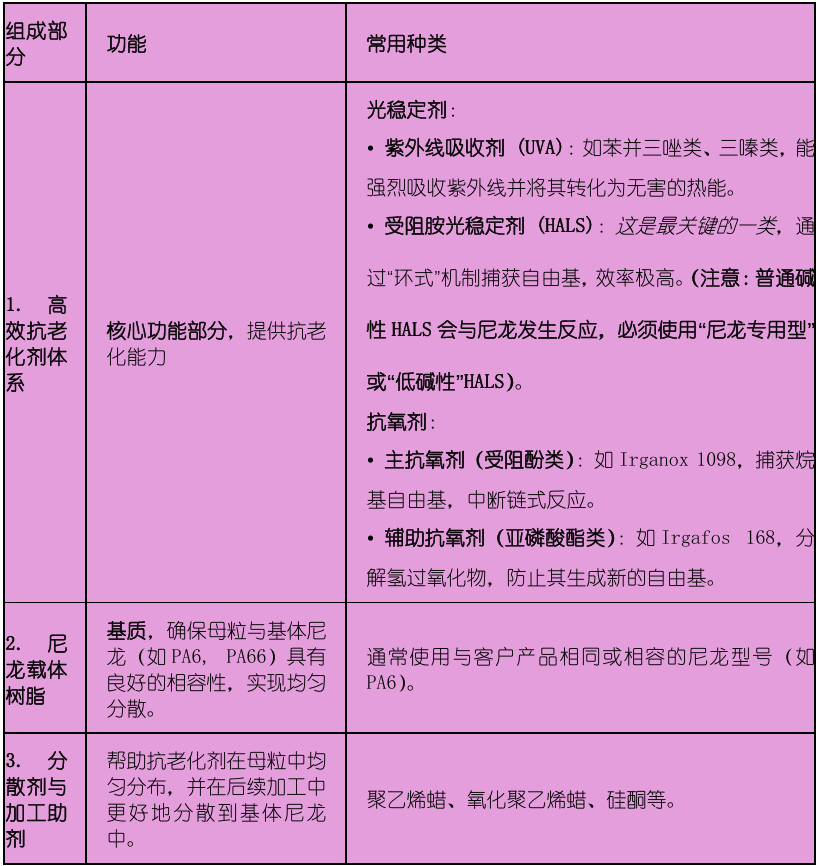Functions and applications of nylon aging resistance masterbatch
Nylon anti-aging masterbatch
Nylon Anti-aging MasterbatchIt is a high-concentration, high-efficiency functional masterbatch with nylon (polyamide) as the carrier. It uniformly disperses various anti-aging additives (mainly light stabilizers and antioxidants) into nylon resin through advanced processing technology to produce a granular product.
Its core function isTo endow or significantly enhance nylon plastic products with the ability to resist aging (photo-oxidative aging and thermal oxidative aging)....thereby extending the service life of the product.
Why does nylon need to be anti-aging?
Nylon itself has excellent mechanical strength, wear resistance, and chemical resistance, but its molecular structure contains amide bonds (-CO-NH-) and methylene groups (-CH2-) which are susceptible to oxygen, heat, especially.Ultraviolet raysVery sensitive. Aging can cause:
Appearance deteriorationDiscoloration, yellowing, loss of luster, surface cracking.
2. Decrease in mechanical performanceStrength, toughness, and elongation decrease, causing the product to become brittle and prone to breakage.
3. Degradation of electrical performanceThe insulation performance deteriorates.
Therefore, nylon products used outdoors or in high-temperature environments for extended periods (such as automotive parts, outdoor sports equipment, electronic and electrical components) must incorporate anti-aging masterbatches.
The core components and mechanisms of anti-aging masterbatch.

Main Functions and Advantages
Extend product lifespanSignificantly delays material degradation caused by light and heat, enabling products to be used for extended periods even in harsh environments.
Maintain appearance and performanceTo prevent yellowing and embrittlement, and to maintain the initial color, gloss, and mechanical strength of the product.
Improve processing stabilityProvide thermal oxidation protection during high-temperature injection molding, extrusion, and other processing to prevent polymer degradation.
Convenient to use, well-dispersed.Adding in the form of masterbatch is more convenient than directly adding powdered additives, as it is dust-free, accurately metered, and has far superior dispersion uniformity compared to direct mixing.
Cost-effectiveAlthough the cost of masterbatch has increased, the overall cost is reduced by decreasing the defect rate and extending the product lifespan.
Typical application areas
Automobile IndustryEngine peripheral components (fans, covers), outer door handles, exterior mirror housings, connectors (harness clamps), etc., need to be resistant to high temperatures and weather.
Outdoor gearOutdoor lighting fixture housings, sports equipment (such as ski bindings), garden tool components.
Electronic appliancesCircuit breaker enclosures, sockets, connectors for outdoor use.
Industrial sectorMechanical parts and pipe fasteners exposed to the outdoors for a long time.
How to choose and use?
1. Select according to nylon typeEnsure that the masterbatch carrier is compatible with your base material (such as PA6 or PA66).
2. Clarify the usage environment:
Outdoor use, primarily for illumination.NeedUV stabilizer (UVA+HALS) AntioxidantComposite system.
Use in high-temperature environmentsEfficiently needed.Antioxidant system。
Harsh environments (such as under a car hood)NeedLight and heat stabilizersA powerful combination.
3. Follow and add ratioThe usual addition ratio is 1% to 3%. The specific ratio needs to be determined through testing according to the concentration of the masterbatch and your performance requirements.
4. Pay attention to the processing technology:
Mix evenlyBefore injection molding or extrusion, thoroughly mix the masterbatch with the nylon base material.
Avoid over-processingExcessive processing temperature and prolonged residence time may lead to the decomposition or volatilization of some additives, affecting their effectiveness.
Nylon anti-aging masterbatch is a key product in modern polymer material modification technology. It efficiently and conveniently addresses the inherent defects of nylon materials. For high-quality nylon products with weather resistance requirements, it is not "optional" but a "necessity" to ensure product quality and reliability. When selecting, be sure to communicate with a reliable supplier to clarify your specific application scenarios and technical requirements.
【Copyright and Disclaimer】The above information is collected and organized by PlastMatch. The copyright belongs to the original author. This article is reprinted for the purpose of providing more information, and it does not imply that PlastMatch endorses the views expressed in the article or guarantees its accuracy. If there are any errors in the source attribution or if your legitimate rights have been infringed, please contact us, and we will promptly correct or remove the content. If other media, websites, or individuals use the aforementioned content, they must clearly indicate the original source and origin of the work and assume legal responsibility on their own.
Most Popular
-

Dow, Wanhua, Huntsman Intensively Raise Prices! Who Controls the Global MDI Prices?
-

Clariant Unveils Cost-Cutting Plan Details, Plans to Shut Down Multiple Plants
-

[Today's Plastics Market] General Materials Weakly Fluctuate, Engineering Materials Steadily Rise
-

Daily Review: Polyethylene Prices Under Weak Consolidation, Sellers Face Significant Pressure to Move Inventory
-

EU Plans to Introduce New Rules Banning 100% Procurement of Chinese Products! Asahi Kasei and Teijin Reach Absorption Merger Agreement






